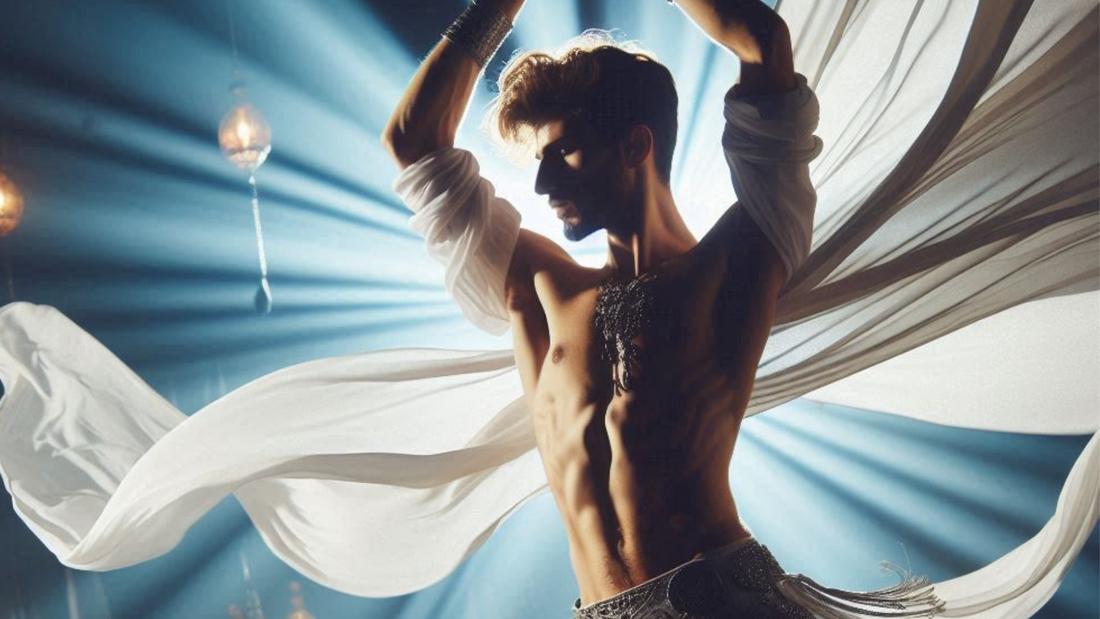
Share
Embracing Diversity: The Role of Men in Belly Dance

Male dancers have been integral to the development of dance in the Middle East, significantly enriching the region's artistic legacy through their performances.
Belly dance is a captivating and expressive art form that transcends cultural boundaries and challenges societal norms. While often associated with femininity, belly dance is an inclusive dance style with a rich history involving both men and women. Throughout the centuries, men have played significant roles in its development and continue to shape its evolution. We'll explore the history, contributions, and challenges faced by men in belly dance, highlighting how they enrich this vibrant art form and contribute to a more inclusive dance community.
Unearthing the Past
The roots of belly dance are complex and diverse, originating in various cultures across the Middle East, North Africa, and beyond. Historically, men have been integral to the performance and evolution of belly dance, often navigating a complex societal landscape to pursue their passion for dance.

Khawals: Pioneers of Male Belly Dance
Khawals of Egypt were some of the earliest male belly dancers. During the 18th and 19th centuries, with women prohibited from performing publicly, Khawals stepped in as entertainers. These male dancers, dressed in women's clothing, incorporated belly dancing into their performances. They were known for their graceful movements, vibrant costumes, and a blend of traditional dance styles.

Khawals occupied a distinctive niche within Ottoman society, balancing the fine line between entertainment and societal norms. Their performances, rich in theatricality, reflect the complexities of gender and culture in the region.
Despite their popularity, Khawals also faced social ostracism and discrimination due to their appearances. While their unique role provided them opportunities not available to others, it also placed them in a complex and sometimes precarious position.
Khawals' contributions to the development of belly dance cannot be understated. Their performances helped preserve traditional dance styles and laid the foundation for the modern belly dance we see today.

Socio-Political Background
During the 18th and 19th centuries, Egypt was under Ottoman rule. The Ottoman Empire had a complex and diverse society with various social classes and roles. Entertainment and performing arts were highly valued, leading to the development of diverse forms of performance, including those that blurred traditional gender boundaries. In Middle Eastern societies of that era, gender roles were rigidly defined, the practice of male performers in women’s clothing challenged these norms and reflected both the restrictive social environment and the evolving nature of entertainment.

Role and Purpose
The performances of Khawals were central to social events like weddings, festivals, and public celebrations, contributing to the festive atmosphere. They entertained audiences with a blend of dance, music, and theatrical elements that were meant to amuse and captivate audiences. Their acts often incorporated elements of humor, drama, and satire.

Status and Origins
Eunuchs were often employed in various roles within Ottoman society, including guards, servants, and entertainers which were often Khawals. While slavery and servitude were common in various parts of the Ottoman Empire, and some Khawals were acquired through these systems, not all were enslaved. Some were free men who chose this profession or were part of a specific class of entertainers.

Khawals were integral to the cultural and social fabric of their time, performing roles that were both entertaining and provocative. Their legacy is a testament to the diversity and complexity of Middle Eastern dance history
Challenges and Stigma
While they brought entertainment to many, their role as male dancers who dressed as women did not align with the traditional norms of the time. Some viewed their performances with admiration and appreciation for their artistic skills, while others were uncomfortable with their non-traditional presentation. This tension led to a complex social standing, where Khawals were both celebrated and criticized.
As concerns about social propriety and morality grew, Khawals faced increasing regulatory pressures. Authorities, intent on enforcing tradition and maintaining public order, began to impose restrictions on their performances. Over time, these restrictions intensified, and in some areas, Khawals were eventually banned altogether. This shift marked a significant change in the entertainment landscape, reflecting broader societal efforts to suppress non-traditional expressions of gender and performance.

Legacy and Influence
Despite facing challenges, Khawals left a lasting impact on Middle Eastern performing arts. Their contributions to dance and theatrical performances influenced the development of various dance forms, including modern belly dance. The legacy of Khawals is evident in the preservation and evolution of traditional dance forms. Modern performers and choreographers often draw inspiration from the historical styles and techniques popularized by them.

Khawals were more than entertainers; they were cultural pioneers who navigated the intricate dynamics of gender and performance. Their contributions to dance and theater in the Middle East are enduring and significant.
Mahmoud Reda and the Reda Troupe
One pivotal figure in the history of male belly dance is Mahmoud Reda, who revolutionized the art form in the 20th century. Reda was a visionary dancer and choreographer who founded the Reda Troupe in the 1950s. His innovative approach to belly dance blended traditional Egyptian dance with elements of ballet and theatrical performance.

Mahmoud Reda's vision and creativity transformed belly dance into a respected and celebrated art form, inspiring dancers around the world.
Reda’s work with the Reda Troupe helped legitimize belly dance and bring it to international audiences. He emphasized storytelling and theatricality in his performances, showcasing the beauty and depth of Egyptian dance. Reda's influence on belly dance was profound, and his legacy continues to inspire dancers worldwide.
Training Dancers Globally
Reda’s impact extended beyond Egypt. The Reda Troupe trained dancers from around the world, helping to spread and standardize belly dance techniques internationally. This training helped establish the formalization of belly dance as a respected art form, influencing countless performers and choreographers globally.

Profile
Background: Born in Cairo in 1930, Mahmoud Reda was a trained gymnast and dancer who sought to elevate Egyptian dance on the global stage.
Reda Troupe: Founded in 1959, the Reda Troupe became renowned for its innovative performances, blending traditional dance with modern choreography.
Impact: Reda's work helped legitimize belly dance as a respected art form, inspiring countless dancers and choreographers worldwide.
Legacy: Mahmoud Reda's influence continues to be felt in the world of dance, with many modern performers drawing inspiration from his work.

Reda's work with the Reda Troupe elevated Egyptian dance, showcasing its beauty and depth to international audiences.
Modern Influence
Today, male dancers continue to make significant contributions to the belly dance community. These artists incorporate traditional and modern techniques, enriching the dance with creativity and innovation. Below are some examples:Tito Seif
One of the most celebrated male belly dancers today is Tito Seif, an Egyptian performer known for his dynamic stage presence and intricate techniques. Tito has gained international acclaim for his ability to blend traditional Egyptian dance with modern influences, fascinating audiences worldwide. His performances demonstrate the powerful presence and artistry that men bring to belly dance, inspiring people of all genders to explore the dance's limitless possibilities.

Tito Seif is a true master of his craft, captivating audiences with his powerful performances and dedication to the art of belly dance.
Global Workshops and Influence
Seif has conducted workshops and performances internationally, sharing his expertise and influencing a new generation of dancers. His contributions help bridge traditional and contemporary styles, fostering a deeper understanding and appreciation of belly dance across different cultures.

Profile
Background: Born in Cairo, Tito Seif began his dance career at a young age, quickly gaining recognition for his talent and dedication.
Performance Style: Tito is known for his dynamic stage presence and masterful technique. His performances highlight the rich heritage of belly dance while pushing its boundaries through innovative approaches.
Impact: Tito has gained international acclaim for his contributions to the art of belly dance, inspiring dancers worldwide with his performances.

Through his performances, Tito challenges stereotypes and inspires dancers of all genders to explore the limitless possibilities of belly dance.
Said El Amir
Said El Amir, a German dancer of Persian descent, is another prominent figure in the world of belly dance. He emphasizes that dance is a universal language that transcends gender boundaries.

Said El Amir is a passionate advocate for inclusivity in belly dance, using his platform to promote understanding and appreciation for male dancers.
Impact on Cultural Perceptions
El Amir’s work has contributed to changing perceptions about male dancers in belly dance. His advocacy efforts have helped to normalize male participation in the art form, encouraging more diverse representations and opportunities within the belly dance community.
Profile
Background: Born in Germany to Persian parents, Said El Amir discovered his passion for dance at a young age, quickly gaining recognition for his talent and dedication.
Performance Style: Said is known for his expressive and dynamic performances, incorporating traditional and modern techniques.
Impact: Said is a passionate advocate for diversity and inclusivity in belly dance, promoting understanding and appreciation for male dancers.

Dance is a universal language that transcends gender boundaries, and Said's work is a testament to the power of inclusivity in the arts.
Rachid Alexander
Rachid Alexander, originally from Curacao, is known for his energetic and captivating performances. Celebrated for his technical accuracy and emotional depth, his performances captivate audiences worldwide.

Rachid Alexander is a trailblazer in the world of belly dance, captivating audiences with his dynamic performances and dedication to the art.
Expanding International Reach
Alexander’s work has helped elevate belly dance’s profile internationally. By performing in diverse settings and integrating various influences, he demonstrates the global appeal of the art form and contributes to its continued evolution.
Profile
Background: Born in Curacao, Rachid Alexander began dancing at a young age, exploring various dance styles before focusing on belly dance.
Performance Style: Rachid is known for his energetic and dynamic performances, blending traditional belly dance with contemporary influences.
Impact: Rachid's work has gained international acclaim, inspiring dancers worldwide with his innovative approach and dedication to the art of belly dance.

Through his work, Rachid challenges stereotypes and inspires dancers of all genders to embrace the art of belly dance.
Cultural Impact and Modern Challenges
The inclusion of men in belly dance has had a profound cultural impact, challenging traditional gender roles and promoting inclusivity in the dance community. As belly dance continues to evolve, male dancers bring fresh perspectives and innovative approaches, enriching the art form with their diverse talents and experiences.
However, despite the progress made, male belly dancers still face challenges. Stereotypes and misconceptions about gender and dance persist, sometimes leading to prejudice and exclusion. The assumption that belly dance is solely a feminine art form can create barriers for male dancers seeking acceptance and recognition. Moreover, male dancers often encounter societal pressures that discourage men from pursuing dance as a profession.
Overcoming these challenges requires resilience and dedication, as well as support from the broader dance community to foster a more inclusive and welcoming environment for dancers of all genders.
Honoring the Legacy and Future of Male Belly Dancers
Men have played a vital role in the history and evolution of belly dance, enriching the art form with their unique talents and perspectives. From the historical Khawals and Mahmoud Reda of the recent past to contemporary performers like Tito Seif, Said El Amir, and Rachid Alexander, male dancers continue to shape the future of belly dance, promoting inclusivity and diversity in the dance community.
As we celebrate the contributions of men in belly dance, it is essential to recognize and appreciate the diverse voices and experiences that make this art form so vibrant and dynamic. By embracing diversity, belly dance can continue to thrive as a powerful and inclusive expression of culture and creativity.


